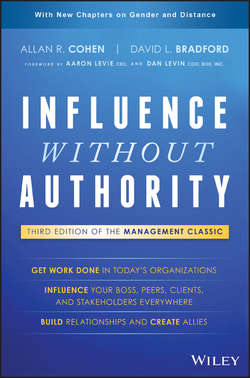Читать книгу Influence Without Authority - Cohen Allan R. - Страница 15
На сайте Литреса книга снята с продажи.
PART II
THE INFLUENCE MODEL
CHAPTER 2
THE INFLUENCE MODEL: TRADING WHAT THEY WANT FOR WHAT YOU'VE GOT (USING RECIPROCITY AND EXCHANGE)
Ignore the Law of Reciprocity at Your Peril
ОглавлениеReciprocity is the almost universal belief that people should be paid back for what they do —that one good (or bad) turn deserves another.3 This belief about behavior, evident in primitive and not-so-primitive societies all around the world, carries over into organizational life. One form in work settings is “an honest day's work for an honest day's pay.”
People generally expect that, over time, those people they have done things for “owe them,” and will roughly balance the ledger, repaying costly acts with equally valuable ones. This underlying belief in how things are supposed to work allows people in difficult organizational situations to gain cooperation. A classic study of prison guards found that threats and punishments alone did not let the guards control prisoners, who greatly outnumbered them.4 The guards did favors for the prisoners, such as overlooking small rule infractions or providing cigarettes, for cooperation from prisoners in keeping order. All the formal authority in the world can't keep rebellious prisoners in line; they exchange their cooperation for favors making their confinement more tolerable, not out of respect for “the rules.”
Even at much higher levels of organizations, little gets done without similar give and take. One manager alerts her colleague that their CEO is on a rampage and should be avoided today. Eventually, the grateful colleague repays the favor, telling the manager what he learned about a competitor's IT strategy. Soon after, the manager hears about a potential new customer whom she refers to the colleague; when the colleague has the chance, he initiates a joint project that can cut several steps from the billing process and save considerable money. The give and take of their relationship makes organizational life better for both.
Give and take can also be negative. The trade can be a loss of a benefit for lack of cooperation, or a cost that results from an undesirable response. Negative trades can be expressed as threats about what will happen in the future, or can result in both parties losing.
It is important to note, as Adam Grant clarifies, that almost everyone balances their exchanges by varying net giving and taking.5 At work most people balance them, and evidence indicates that those who don't create value for others end up losing, as we will discuss.
3
Alvin Gouldner, “The Norm of Reciprocity: A Preliminary Statement,” American Sociological Review 25 no. 2 (1960): 161–78.
4
Gresham M. Sykes, Society of Captives: A Study of a Maximum Security Prison (New York: Atheneum, 1969).
5
Adam M. Grant, Give and Take: Why Helping Others Drives Our Success (New York: Viking 2013).
